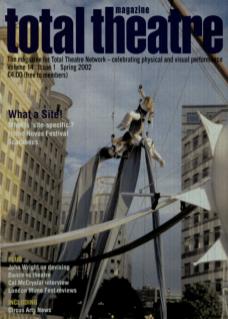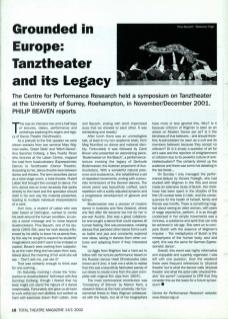his was an intensive two and a half days of lectures, videos, performance and workshops exploring the origins and legacy of Dance Theatre (Tanztheater).
As a prelude to the first speaker we were shown extracts from two seminal Mary Wigman works, 'Green Table' and 'Witch Dance'. Ana Sanchez Colberg, a fiery Puerto Rican who lectures at the Laban Centre, mapped the road from Ausdruckstanz (Expressionistic Dance) to Tanztheater (Dance Theatre). According to her, dance theatre lives between dance and theatre. The term describes dance as a total stage event, a total theatre. Rudolf Laban first brought this concept to dance. For him, dance was an inner necessity that spoke directly to the heart and the spectator should distil in his own way the material presented, leading to multiple individual interpretations of a work.
Kurt Joos, a student of Laban who was later based at Dartington, wanted to centre his work around the human condition, to convey a social message and to move beyond Ausdruckstanz. Pina Bausch, one of his students (1955-59), sees her work directly influenced by his ability to leave his students free, by the way he sought to expand his students' imaginations and didn't want to be imitated or copied. Bausch sees working from subjectivity as the main thing she has taken from Joos. Asked about the meaning of her work she will say - 'Don't ask me, just see it!
That was certainly enough to think over for one evening… On Saturday morning I chose the 'Introduction to Ausdruckstanz' technique with Ana Sanchez Colberg, though I feared that my body might not stand the rigours of a dance masterclass. Fortunately she gave us all room to work within our own abilities, but worked us hard with exercises drawn from Laban, Joos and Bausch, ending with short improvised duos that we showed to each other. It was exhilarating and sweaty!
After lunch there was an unintelligible talk, at least to my non-academic brain, from Meg Mumford on dance and national identity. Fortunately it was followed by Carol Brown who presented an astonishing piece, 'Bodenweiser on the Beach', a performance lecture invoking the legacy of Gertrude Bodenweiser, the Austrian proponent of Ausdruckstanz. With a wonderful natural presence and exuberance, she established a set of repeated movements, ending with a pirouette reminiscent of the Dervish dances. The whole piece was beautifully crafted, each repetition with a subtly adjusted dynamic and a progressive development of gesture and tempo.
Bodenweiser was a pioneer of modern dance in Australia and New Zealand, where she fled after life became too hot for her in pre-war Austria. She was a great collaborator and sought a dance that could express all human feeling. She was provocative, creating dances that parodied other dance forms such as ballet and jazz and constantly explored new ideas, taking in dances from other cultures and adapting them if they interested her.
Liz Aggis from Brighton had a hard act to follow with her lecture-performance based on the Russian dancer Heidi Dhinskowska (also known as Hi Jinx). It took me a while to realise that this was a beautifully fabricated parody of our desire to create icons from the past (complete with original film clips from 1904!).
The most controversial contribution was "Conspiracy of Silence' by Marion Kant, a research fellow at the host university. Her fundamental thesis is: Mary Wigman collaborated with the Nazis, but all of her biographers have more or less ignored this. Why? Is it because criticism of Wigman is seen as an attack on Modern Dance per se? Is it the blindness of true believers - and should therefore Ausdruckstanz be seen as a cult and its members believers because they accept no criticism? Or is it simply a question of art for art's sake and the rejection of enlightenment or criticism due to its powerful culture of antiintellectualism? This certainly stirred up the audience and there was some hot debating in the tea break...
On Sunday I only managed the performance-lecture by Sondra Fraleigh, who had studied with Wigman in the 50s and since made an extensive study of Butoh. Her childhood had been spent in the shadow of the first US nuclear tests in Utah, and the consequences for the health of herself, family and friends was horrific. There is something magical about seeing an older woman, with years of stage experience, perform. It is as though condensed in her simple movements was a richness, a substance and spirit that can only be achieved in old age. She went on to compare Butoh with the essence of Wigman's impulse - 'the metaphysics of Butoh is the metaphysics of the human body, soul and spirit; this was the same for German Expres. sionistic dance'.
Overall, this event was highly informative and enjoyable and superbly organised. I was left with one question. Over the weekend there were frequent references to 'physical theatre' but is what the dancer calls physical theatre' and what the actor calls physical the atre' the same? I proposed to CPR that they consider this as the basis for a future symposium!
Centre for Performance Research website: www.thecpr.org.uk

